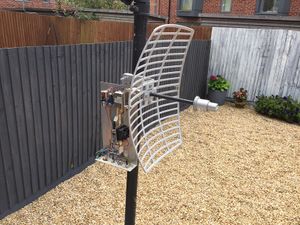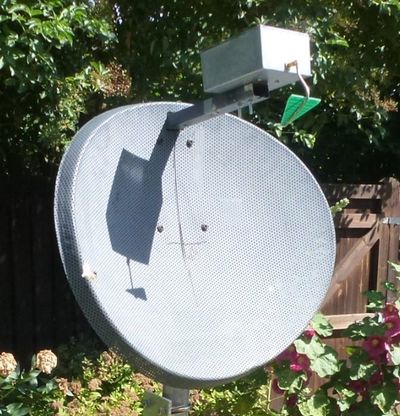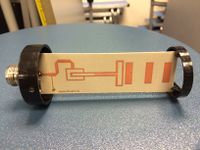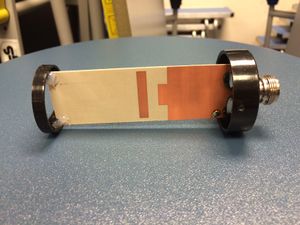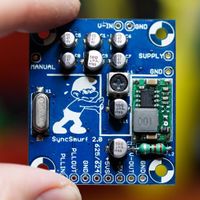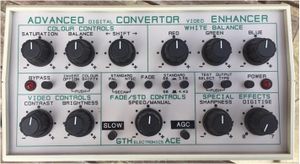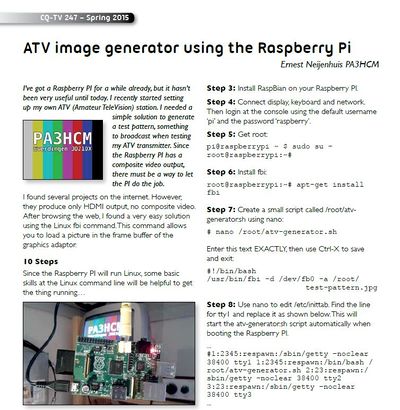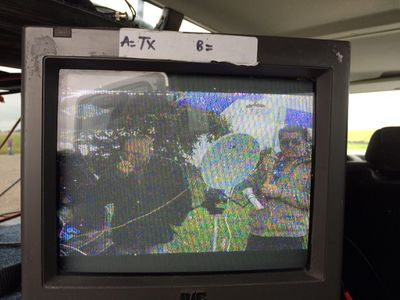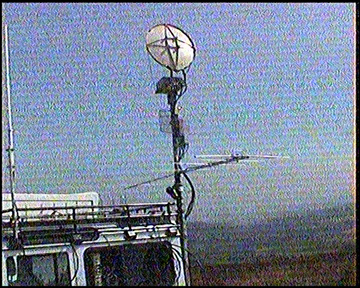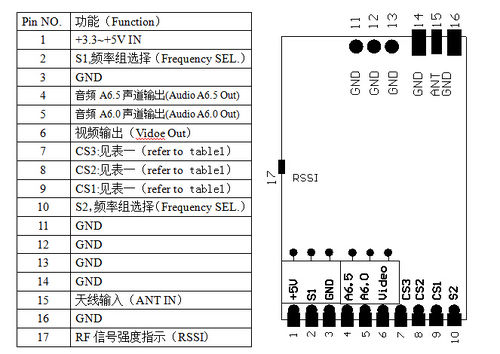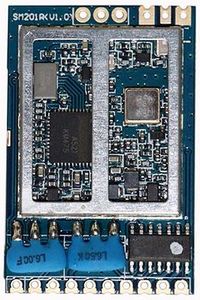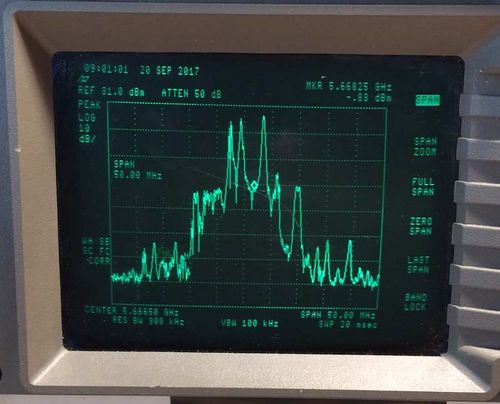5.6 GHz
It is very easy (and low cost) to get on the air on 5.6GHz (the 6 cm amateur band), using the cheap modules intended to transmit “First Person Video” (FPV) back from drones to their operators. These units can be used without any modifications to get on air, and with simple WiFi plate or dish antennas (and a clear line of sight path) can be used to send pictures to stations using the same equipment over paths in excess of 50km.
M0KPW has an excellent website describing his 5.6GHz system http://www.5-6ghz-atv.co.uk/
Frequency choice
The UK amateur band plan is shown on the RSGB website here: https://thersgb.org/services/bandplans/html/rsgb_band_plan_2017.htm
GB3KM has a licenced input on 5665 MHz and this has been chosen as the primary ATV operating frequency. Audio WB-FM operators have been using 5825 and 5840 MHz. 5825 MHz is too close to the band edge for ATV, and 5840 MHz is marginal.
The FPV equipment receive and transmit frequencies are set using DIP switches, and most tune to 5665 MHz – but care needs to be taken when selecting equipment to make sure it does cover this frequency. Example channel tables are shown at the bottom of this page.
Equipment
The FPV units are widely advertised on eBay and other sites with titles similar to “Tarot 5.8G 600MW Telemetry TX/RX Combo for FPV Image Transmission TL300N” and are available at reasonable prices. The typical units are very small but have reasonable FM-TV performance with a quoted transmitter spec of 600mW output and receiver sensitivity of -80dBm. Amplifiers are available to raise the output power to 2 watts or more.
Be aware – we have found that on some receiver units, the video output is on the Red phono lead and not the expected Yellow lead!
Mounting the equipment
Due to the very high losses in co-ax cable at 5.6GHz it is recommended that you mount the units very close to the antennas and run long 12V dc, audio and video cables back down to the shack or operating position.
Be aware also, that whilst these units are very small they do run very hot in operation, and it is suggested that you provide a good heatsink for both Tx and Rx – mounting them in a diecast box on the back of their respective antennas is ideal.
Details of G8GKQ's transceiver setup is shown here (receiver unit on left & transmitter with fan on the right)
Transmit amplifiers
Whilst the basic units work very well and have been used to transmit over paths of 60km, power amplifiers to boost the 600mW transmitter signal to 2—4 Watts are available from several suppliers on eBay and other sites, and will significantly increase the path length that the units will work over. These amplifiers should be connected after the transmit unit, but before any antenna change over relay(s) – and remember that his will increase the volt drop on any long 12V cable feeding the transmitter at the masthead.
Be warned!! Several users have found these PAs to be "fragile", so you should always make sure that the antenna is connected – and all connectors done up tight – before applying dc or RF power. We are investigating whether they can be made more reliable by reducing the volts / input drive.
Antenna changeover relays
The FPV equipment comes as separate Tx and Rx units. In order to operate on a single antenna, you will need an antenna changeover relay. Note, however, that the losses at 5.6GHz can be significant and care must be taken when wiring up the units to ensure RF cables are of good quality, and kept to a minimum length – semi-rigid cables fitted with SMA connectors are ideal.
PL259 and even BNC connectors are very lossy at 5.6GHz and should not be used, but the surplus SMA relays often available at rallys are ideal for 5.6 GHz.
See this wiki page for more details on suitable relays, 24 volt operation, and 4 port (or transfer) relays.
If no suitable relay is available, it may be cheaper to use separate antennas for receive and transmit as shown in the picture below – note the Tx and Rx units are mounted directly on the back of the flat panel antennas.
Reverse SMA
Be aware that all the 5.6GHz FPV units use "reverse SMA" connectors (as used on WiFi equipment) and that all low-loss cables (unless bought specifically for the purpose) and surplus SMA relays will almost certainly have standard SMA connectors – which will not fit. Adapters from reverse to standard SMA are available on eBay or other suppliers – search for "RP-SMA to SMA adaptor" or similar wording.
Antennas
As 5.8GHz is used by broadband wireless networks, there is a wide choice of antennas available for use on 5.6GHz ATV. These can range from flat plates/panels to wire mesh (grid) dishes, as seen in the above pictures.
Horizontal polarisation has been chosen as the standard (waveguide feeds needs to have the long dimension of the aperture – and/or horn – vertically oriented when feeding dishes)
Satellite dishes
It is also possible to use a satellite mini dish with a suitable feed, such as a waveguide/horn to the design by G4NNS – see here for construction details: http://myweb.tiscali.co.uk/g4nns/FeedHorn.html
The picture shows a Sky mini dish fed with a WA5VJB log-periodic PCB feed http://www.wa5vjb.com/products1.html – these are available in the UK from G4DDK. http://www.g4ddk.com/Prices.html
Dishes of this size typically have a beam width of 4—8 degrees.
M1BKF found a very interesting 5.6GHz feed for standard f/d ratio satellite dishes; it contains what looks like a PCB yagi, and is available from http://www.antennas-amplifiers.com/5.1-5.5-5.8GHz-WLAN-WiFi-Antenna/Feed-Illuminator-satellite-offset-dish-fd-0.5-0.8
DIY BiQuad antennae
This web page http://buildyourownantenna.blogspot.co.uk/2014/07/double-biquad-sector-antenna-for-5-ghz-wifi.html has a well engineered double BiQuad antenna with a quoted 13dBi gain.
Note in the picture G8JAN has directly connected the Tx module to the antenna to avoid co-ax losses.
Video equipment - Rx
The receiver output will need to be directly connected to a monitor with a composite video input to view the received the signal – normally on a yellow phono or RCA connector.
Video squelch defeat
Beware of using modern flat-screen monitors which have a video squelch – these will not display noisy signals, and just give a blue screen until they get a strong video signal.
There are a number of circuits around to defeat the squelch and also improve the readability of the signal.
===Syncsmurf by PE1RQM=== – kits are available; details on the webpage here.
Results are very impressive:
eachine FPV recorder
Several people have reported that they are using these devices, available from various sites, and as well as defeating the monitor blue screen by inserting syncs on noise they have a single push button record facility. They record to an SD card which can be removed and the files viewed on a PC; users report that you need to use a good quality SD card, and that they have had problems with Kingston branded cards – Sandisk are preferred.
Video sync processor
Or any video sync processor may be usable such as the Advanced Converter Enhancer used by many stations on 23cms FM TV transmissions.
Video equipment - Tx
An old camcorder with a yellow phono "video out" socket is an ideal video and audio source for the transmitter.
Don't forget that you will need to display your call sign to remain legal. This can be a video generator, a .jpg card reader with video out, or a piece of card with your call sign scribbled on it!
Media card reader
A simple way to generate test patterns is to use a media card reader loaded with .jpg files – these are available on several sites, just search for "SD card media AV player" – but make sure you get one which outputs PAL video.
PicDream
The PicDream project uses a single PIC chip and a 4MHz crystal to generate a black and white test pattern – simple but effective – the original project was described in CQ-TV 180 and re-printed in CQ-TV 247.
The PIC code is available for download here: batc.org.uk/cq-tv/software/picdream.zip
Raspberry Pi - PA3CHM image generator
CQ-TV 247 published details of a simple RPi-based test card generator by Ernest PA3CHM.
Full details are on his website: http://www.pa3hcm.nl/?p=248
Raspberry Pi - Portsdown patterns
The BATC Portsdown project can be configured to deliver composite video and audio out from the RPi multi-jack plug.
This can be test patterns, RPi desktop, or the Portsdown camera and microphone – see this wiki page for more details making the RPi the only piece of video/audio equipment you need to drive the 5.6GHz transmitter.
Stand alone Raspberry Pi animated test card generator
This is the stand alone version of the animated test card generator that is part of the Portsdown software. - see this wiki page for more details
On the air
Using dish aerials of 30—60cm, line of sight ranges of 80km can easily be achieved.
P5 (noise free) FM ATV pictures have been exchanged over a 138km path using the equipment described on this page – the picture below shows G4CPE/P on Dunstable Downs being received at the Ridgeway, near Didcot, over a slightly obstructed 66km path.
Dunkery Beacon near Minehead, to Cleeve Common near Cheltenham.
The picture shows G8GTZ/P received by G8GKQ/P over the 138km path.
The current UK "record" for a contact using standard FPV units stands at 153km between GW3NWR/P at Bylchau, North Wales to M0KPW/P and G0HIK/P at the Kirkstone Pass Inn, Cumbria.
FM voice only
Several stations in the Gloucester and Bolton area are using these units for wideband FM voice only. This is achieved by simply putting high level (1V peak-peak) audio on the yellow video TX phono input – this modulates the main high level carrier with audio rather than video (the two audio phono connectors – red and white – can be ignored). On RX, the yellow phono connector of the receiver is simply connected to a line level input of an audio amplifier.
It is done this way because the two audio subcarriers transmitted by the unit are at a level 20dB lower than that of the main (video)carrier. However, as it is using the same bandwidth Rx and Tx system, performance will be no better than FM video – ideally the 480MHz RX IF would be tapped off in to an SDR or narrow band receiver to give significantly enhanced (+20db?) narrow band performance.
Activity hot spots
There is a Google map showing approximate locations of stations thought to be active on 5.6GHz FM – if you are on 5.6GHz, you can add or edit your station: https://www.google.com/maps/d/u/0/edit?mid=1e4keFSFWy6wLUQNF3IT3n6h90eU&ll=52.39133141509076%2C-1.8917942000000494&z=7
Known users include:
- Southern England = G8GKQ, G8GTZ, G0UHY, G8XZD, G4UVZ, G3VPF
- Dunstable area = M0SKM, G4CPE, G0WFT
- North-East = GB3KM, G1LPS, M0DTS
- Cheltenham = G0LGS, M0RKX and G4NZV (using WB audio only)
- Bolton Wireless Club = G4JLG, G6GVI, G8PEF, M0UFC, MW1FGQ (PW “Siren” Article)
- Ludlow, Shropshire = G8XYJ
- Yorkshire = G8BYN
- Norfolk = G4NJJ, G8JAN, G4WVU and M1BKF
- Cumbria - Barrow-in-Furness Radio Club project
- Merseyside - G3NWR
More information
Dave G8GKQ did a presentation at the BATC annual convention CAT17 in September 2017 on getting started on 5.6GHz ATV.
- The presentation is available here https://wiki.batc.tv/images/4/42/CAT17_5.6_GHzv2.pdf
- The video of the session is available on the BATC YouTube channel here https://www.youtube.com/watch?v=XJzGNsGmE9Y
On line support / social media
There is a thread running on the BATC forum where the ATV community are exchanging ideas and also posting results of the latest on air tests. http://www.batc.org.uk/forum/viewtopic.php?f=2&t=5026
Note that the BATC core team do not regularly visit Facebook pages - time is just too short to monitor everything and it's not easy to follow threads on Facebook.
Technical information
SM201R
The large RX chip in most units has had the part number removed, however it appears that a lot of receivers use the SM201R module. The spec and pinout are shown below but notice the frequency range of this particular unit does not seem to cover 5665MHz, so make sure the one you buy does!
S meter output
Looking at the above table, it appears that the RSSI is available on pin 17 of the SM201R and could potentially be used for a signal strength meter to help align the antennas when setting up a QSO.
It also appears that the SM201R uses a 480MHz IF (same as the Comtech) and potentially could be modified with narrower filters to improve RF performance.
Tx and Rx perfomance
Initial measurements suggest the TX bandwidth is 25—30MHz.
This accounts for the quoted RX sensitivity at -80dBm which may be improved by an LNA but will ultimately be limited by the RX IF bandwidth.
Channel Listings
As mentioned above, the channel settings vary from manufacturer to manufacturer. This table is taken from the Tarot data sheet which uses the SM201R module but does include 5665MHz:
And this is the table for the Eachine TS835 transmitter:
This table is from a "Fat Shark" transmitter that does not cover 5665 MHz:
